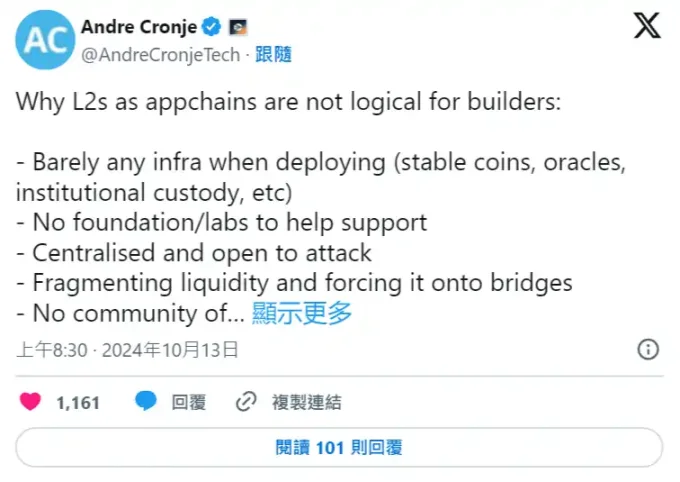Andre Cronje pointed out that application chains (Layer 2) have underestimated the costs of infrastructure and compliance, spending $14 million by 2024, much of which is recurring costs.
Written by: James, BlockTempo
Since pioneers like Arbitrum and Optimism began building Layer 2 networks on Ethereum a few years ago to support faster and cheaper transaction experiences, Layer 2 networks have emerged rapidly. According to L2Beat data, there are currently 73 operational Layer 2s, 20 Layer 3s, along with 81 upcoming projects and 12 archived projects.
However, Andre Cronje, known as the father of DeFi and director of the Fantom Foundation, along with Sonic Labs' CTO Andre Cronje, took to Twitter today to criticize L2, stating that L2 as application chains is illogical for developers, listing several reasons:
- Almost no infrastructure at deployment (stablecoins, oracles, institutional custody, etc.)
- No foundation or lab providing assistance
- Centralized architecture is vulnerable
- Fragmented liquidity and forced cross-chain bridges
- No user and developer community
- Time spent addressing the above issues instead of focusing on applications and users
- Eliminates network effects
- Transaction confirmation times are still long (some providers are unwilling to cooperate)
- Developed in isolation (no collaborative teams)
Andre Cronje also stated that application chains severely underestimate the costs of infrastructure and compliance (including browsers, hosts, trading platforms, oracles, bridges, toolkits, integrated development environments, deposits and withdrawals, native issuance and integration, regulation, compliance), with application chains already spending $14 million in 2024, a significant portion of which is recurring costs.

In response to Andre Cronje's statements, developers have been vocal. Some developers expressed agreement, stating, "I 100% agree, building products on application chains is meaningless without the support and help of a foundation," and "Given such large expenses, I'm curious why more L2s are being launched; it takes a lot of transactions to make a profit."
However, some developers held differing opinions. One developer stated that while the available infrastructure for generic L2s is limited, stronger composability between L2s (and even L1s) completely eliminates the need for local stablecoins, oracles, and institutional custody, and few understand the framework shift.
This developer disagreed with many of Andre Cronje's points, emphasizing that L2 application chains are indeed decentralized and secure. He admitted that the infrastructure costs of application chains may be higher than those of standalone applications, but he firmly believes that as competition for service demand intensifies, many infrastructure costs will trend towards zero.
Andre Cronje Advocates for Sonic
In Andre Cronje's view, Layer 1 should focus on enhancing its scalability through technology rather than continuously creating Layer 2s that generate problems. He is currently leading the design and development of the Layer 1 blockchain Sonic (formerly Fantom). The Fantom Foundation first disclosed last October that it would launch Sonic, aimed at improving scalability and efficiency.
In early September this year, the Sonic testnet officially went live, and on September 25, Andre Cronje announced that the Sonic mainnet would officially launch in December, inviting developers to build applications on its ecosystem. He also mentioned that Sonic introduces a credit scoring mechanism, with the potential to become the first public chain to unlock a $11.3 trillion market (the global unsecured loan market size).
At that time, Andre Cronje heavily promoted the performance of his Sonic network, including that up to 90% of transaction fees would be returned to developers, transaction throughput (TPS) exceeding 10,000 transactions per second, transaction finality (TTF) of about 1 second, support for native stablecoins, and in bridging with Ethereum, he is committed to developing new native bridging technology for Sonic Gateway to significantly enhance the security and convenience of transferring assets from other chains.
免责声明:本文章仅代表作者个人观点,不代表本平台的立场和观点。本文章仅供信息分享,不构成对任何人的任何投资建议。用户与作者之间的任何争议,与本平台无关。如网页中刊载的文章或图片涉及侵权,请提供相关的权利证明和身份证明发送邮件到support@aicoin.com,本平台相关工作人员将会进行核查。




